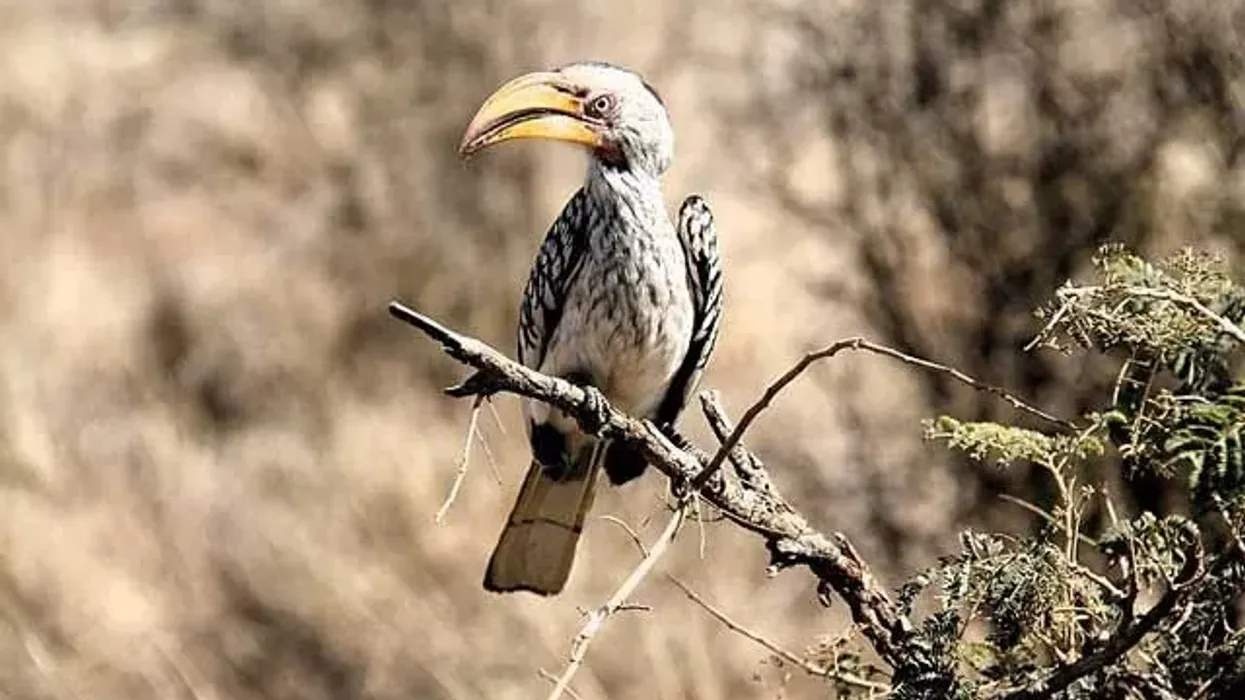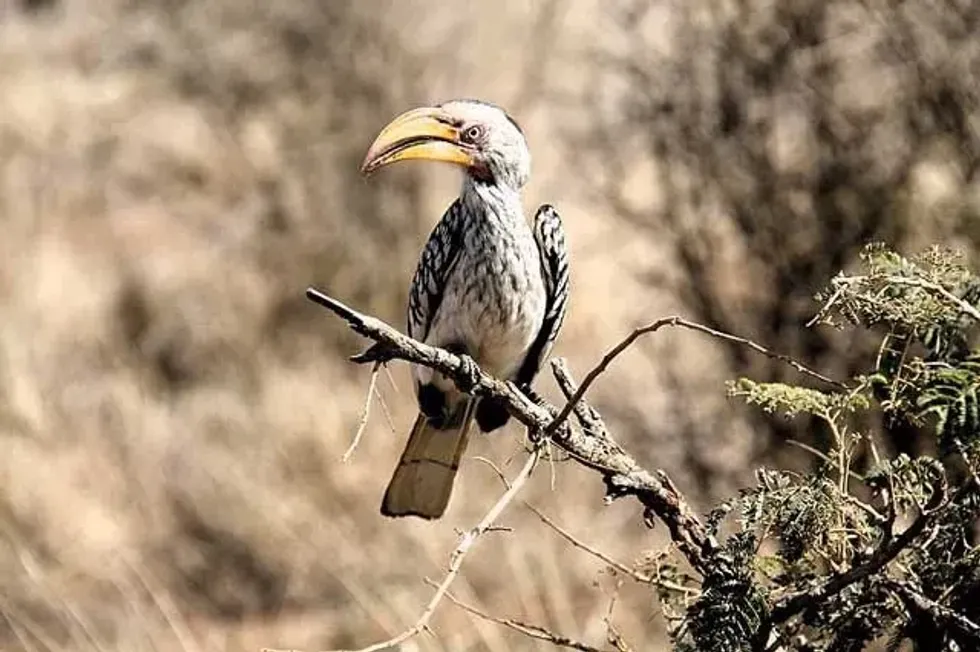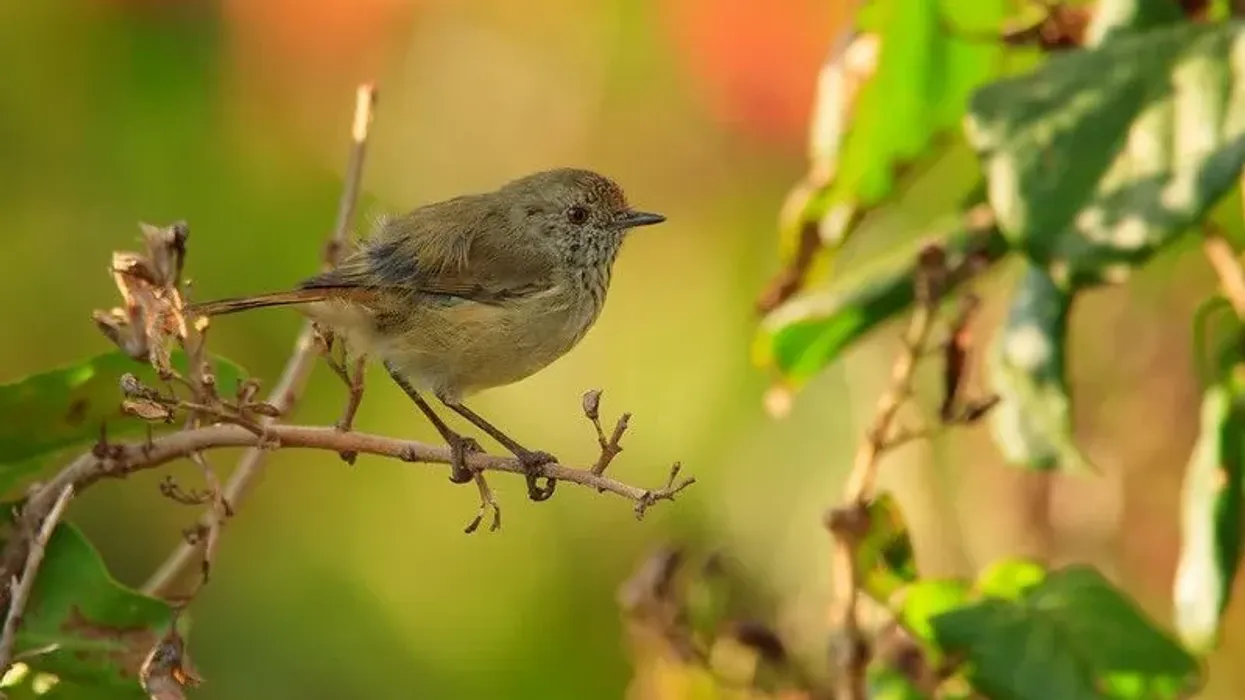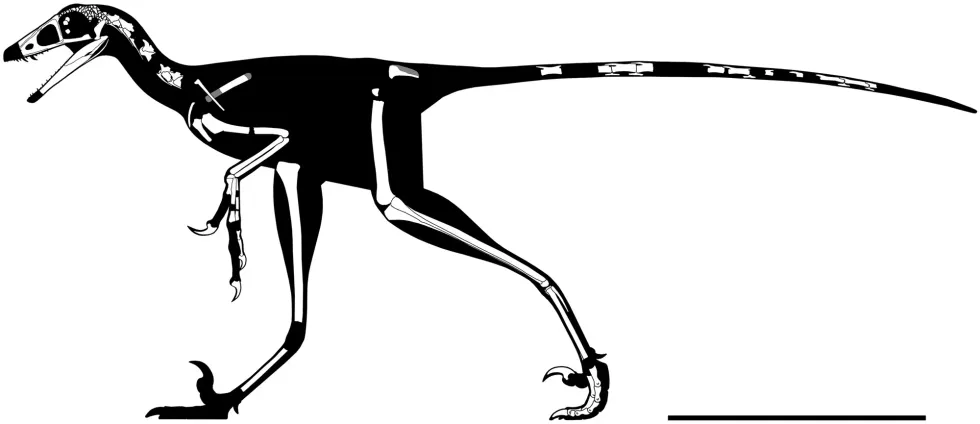Have you ever wondered what bird you saw in the famous Lion King movie? Then, you are just in the right place! So here we present about that Aves species the yellow-billed hornbill.
The southern yellow-billed hornbill, scientifically known as Tockus leucomelas, belongs to the Bucerotidae family. These hornbills with yellow beaks adapt to dry thorn fields of savanna habitat in southern Africa.
It is a greyish white bird with a long curved bill. The ornamental casque of these hornbills is of modest size, and the casque flatly covers the entire beak. The length of their wings is 19 in (25.4 cm).
These hornbills sing a typical cacophonous song in a group. They feed on insects, seeds and also eat snakes. They are active during the entire day and roost on tall trees at night.
Check our articles on carrion crow facts and great green macaw facts as well!
Southern Yellow-Billed Hornbill Interesting Facts
What type of animal is a southern yellow-billed hornbill?
The southern yellow-billed hornbill of the genus Tockus is a bird. It is a hornbill of the Bucerotidae family.
What class of animal does a southern yellow-billed hornbill belong to?
The Tockus leucomelas belongs to the class Aves.
How many southern yellow-billed hornbills are there in the world?
Though the exact population is not known, the population is widespread in its habitat range and also in farmlands in its captivity.
Where does a southern yellow-billed hornbill live?
The hornbill Tockus prefers dry savannas of southern Africa. It is endemic to Botswana, Zimbabwe, and northern South Africa, Angola, and Namibia in the west, and Mozambique and KwaZulu-Natal in the east.
What is a southern yellow-billed hornbill's habitat?
The southern yellow-billed hornbills adapt to the dry open savanna's thorn fields and the woodlands. They choose broadleaved and acacia woodland. The highest concentration of these hornbills is recorded in open mopane scrub.
Who do southern yellow-billed hornbills live with?
The yellow-billed hornbill (Tockus) is a loner. It is a solitary bird and is mainly found alone, except during breeding and migration.
How long does a southern yellow-billed hornbill live?
In captivity, the yellow-billed hornbill (Tockus) is recorded to live for up to 20 years.
How do they reproduce?
The breeding season of the yellow-billed hornbill (Tockus) is from September to March. The peaks of the egg-laying are seen during October and November. The breeding period varies for different local birds as it has to be a wet rainy season. The breeding starts with the first autumn rainfall.
During courtship, the female is offered food, and mutual grooming takes place in the process of copulation. Finally, the breeding pairs check for the prospects of an ideal nest that matches the requirement.
The nests are placed in cavities of trees and cliffs between 3.3 to 39.3 ft (1-12 m) from the ground. The yellow-billed hornbill (Tockus) is territorial about its nest.
After mating, the male stays with the incubating female. The female deposits one to three eggs in the nest. Then, it seals itself with the nesting eggs within the nest, and the nest is closed from outside. The male provided mud to close the entry.
The nesting site is aligned with a vertical slit hole from top to bottom. From here, the male drops food into the nest with the help of his bill. This hole also acts as a mode of ventilation.
The eggs hatch after 24 days. The female leaves the nest when chicks are half grown to help the male supply food. The chicks expel out of the cavity when fully grown and start to fly. The chicks are born with pink skin.
What is their conservation status?
The yellow-billed hornbill is listed as of Least Concern species by the International Union for Conservation of Nature.
Southern Yellow-Billed Hornbill Fun Facts
What do southern yellow-billed hornbills look like?

The billed hornbill (Tockus leucomelas) is a hornbill of Africa. In-flight, it looks like a flying banana.
As the name signifies the emphasis on the down-curved long yellow beak, the bills of these birds occupy 1/6th of birds' total body length. The male bill is 3.5 in (8.9 cm) in length, and the female bill is 3 in (7.6 cm).
The characteristic casque is moderately small and covers the entire length of the beak in males. In general, these birds possess stubby legs and toes and long eyelashes and tails.
Their back is black with white patches, and their belly is white. The chest is lightly dabbed with black stripes, whereas the neck has grey patches. Their yellow eyes are outlined pink, and so is their malar stripe.
How cute are they?
The yellow-billed birds might not look elegant or colorful to the human eye. But these are specifically referred to as a species of softbills because of their gentle and harmless nature.
How do they communicate?
These birds use these loud calls either to define their territory or for communicating to long distances. Their audio calls include grunting, whistling, cackling.
How big is a southern yellow-billed hornbill?
The yellow-billed hornbill (Tockus leucomelas) is a medium-sized bird, it can grow to a length of 19 to 24 in (48 - 60 cm), which is twice as small in length as the southern ground hornbill and much lighter in weight.
How fast can a southern yellow-billed hornbill fly?
The yellow-billed hornbill (Tockus leucomelas) can fly at 18-20 mph (29-32.2 kph). Their under-wings coverts that enhance the flow of air are absent in this Tockus bird. They fly vigorously with heavy wing beats and alternates short gliding periods.
How much does a southern yellow-billed hornbill weigh?
They weigh around 0.3-0.5 lb (132 - 242 g). The female birds are smaller than the males.
What are the male and female names of the species?
The males and females of this species are called male yellow-billed hornbill and female yellow-billed hornbill.
What would you call a baby southern yellow-billed hornbill?
The baby of the billed hornbill (Tockus leucomelas) is called a chick.
What do they eat?
Their diet consists of insects like beetles, grasshoppers, and caterpillars. Its prey items also include snakes, small mammals, and scorpions. In addition, fruits, seeds, berries are their food source. They are not known to be fussy eaters.
They grab their food with the support of their vast bill. They hold the prey between the tips and flip it back to the throat, and crush it with the support of their fine teeth. Though the billed hornbill (Tockus leucomelas) are not ground-dwelling, they pick most of their food from the ground, be it insects or seeds.
Are they poisonous?
Tockus leucomelas are not poisonous, though they eat toxic nuts that other animals don't prefer; the hornbills can expel these poisonous seeds as they do not crack the nut while eating.
Would they make a good pet?
This Tockus species bird is an ideal one to own as a pet. These birds have softbills and can be tamed easily. But it is suggested to have one from the aviaries.
Did you know...
The great hornbill is the bird that contains the large yellow bill, and the hornbill that can register a lifespan of 70 years in captivity is the Southern ground hornbill. It can live for 50-60 years in its natural habitat.
The yellow-billed hornbills eagerly wait at the mongoose burrows for the latter to forage for food as these hornbills get their share of food from the latter, and they alert these mongooses about predator threats.
During nesting, the females take advantage of being locked in the nest, shed tail and flight feathers, and rebuild them.
Are they predators?
Yellow-billed hornbills (Tockus leucomelas) are predatory. They can even attempt to kill a passing snake by hitting it against a hard surface.
The southern yellow-billed hornbill sound
The southern yellow-billed hornbill has a peculiar clucking call. If one hornbill initiates the call, others join, and the output is a harsh, loud, cacophonous audio call.
Here at Kidadl, we have carefully created lots of interesting family-friendly animal facts for everyone to discover! Learn more about some other birds from our frigate facts and secretary bird facts pages.
You can even occupy yourself at home by coloring in one of our free printable southern yellow-billed hornbill coloring pages.









